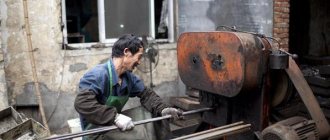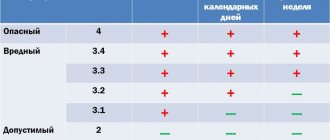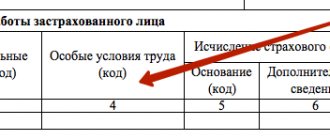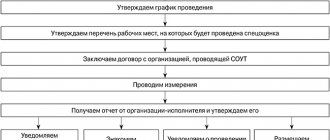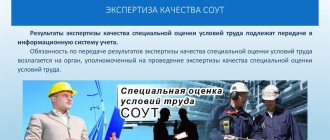Why are sanitary and hygienic criteria needed?
This term refers to indicators used to differentiate the degree of deviation from the norm in the conditions of the production industry and violations in the labor sphere. The norm is considered to be the maximum permissible values to which various indicators correspond.
The sanitary and hygienic characteristics of working conditions are compiled by the Office of Rospotrebnadzor in each region of the Russian Federation. The purpose of determining the limit parameters for assessing working conditions in the workplace is as follows:
- control the level of harmfulness and danger of the conditions in which workers have to perform their work duties;
- equip workplaces in accordance with current sanitary and hygienic rules and regulations;
- set priorities in organizing recreational activities and recreation for staff.
Thanks to information about sanitary and hygienic working conditions at enterprises, state administrations of districts, cities and entire regions can create information databases, certify workplaces according to the described characteristics, and certify the quality of services in accordance with labor protection standards.
When hiring, it is extremely important to compare the health status of the applicant with the work environment in which he intends to carry out professional activities. Sanitary and hygienic working conditions are also taken into account when conducting periodic medical and preventive examinations, investigations of cases of occupational diseases, injuries, and poisoning.
Hygienic criteria for assessing working conditions based on hazard indicators
Sanitary facilities at the enterprise
In Russia, there are special documents, the scope of which applies to all enterprises where physical labor is used. The document is intended for special services and officials:
- Rospotrebnadzor;
- Services that certify workplaces (for example, for engineers);
- Employers;
- Employees and applicants;
- Medical institutions (laboratory technicians and doctors).
Classification of labor hazard factors
Carrying out professional activities, a person has to deal with various factors that negatively affect his health. These include complex equipment, the environmental situation, and hard physical labor. All these conditions have a harmful effect on the body, provoke the occurrence of occupational diseases, cause temporary or permanent loss of performance, reduce resistance to somatic and infectious diseases, lead to reproductive problems, etc. In accordance with the sanitary and hygienic characteristics of working conditions, harmful factors divided into several categories.
What else needs to be remembered when developing sanitary standards for working conditions
The first thing an organization should remember when creating workplaces is the implementation of safe standards and criteria. It is necessary to regularly conduct medical examinations and, based on their results, create statistics on changes in the health status of workers, analyze the harmfulness of workplaces and the frequency of occupational diseases and injuries. When developing sanitary standards, it is worth remembering the availability of jobs with employment opportunities for women. Intra-production specifics and personal protection measures for workers (uniforms, masks) must be taken into account.
Rospotrebnadzor
Hygienic sanitary conditions at the enterprise are what will accompany workers throughout every working day. In hazardous industries, hazard indicators are important even for accountants, security guards and secretaries who are not involved in physical labor.
Physical hazard
The first group is physical or natural conditions. First of all, these are temperature fluctuations, dampness and air circulation, and thermal radiation. This group also includes non-ionizing electromagnetic and electrostatic fields with industrial frequencies up to 50 Hz against the background of an inflated radio frequency or optical range. Among physical harmful factors, the following are considered particularly dangerous:
- laser, radiation and ultraviolet radiation;
- increased noise level in production, ultra- and infrasound;
- local and general vibration;
- contact with fibrogenic aerosols.
Harmful factors that do not comply with the established sanitary and hygienic working conditions in the workplace are also considered to be the absence and insufficiency of natural or artificial lighting, including direct and reflected glare, pulsation of illumination.
Ultraviolet radiation
The requirements of Section 9 of the Rules apply to radiation generated by sources with temperatures above 2000 °C (for example, molten metal, quartz glass), luminescent sources used in printing, chemical and woodworking industries, agriculture, film and television filming, flaw detection and others. industries, as well as in healthcare (clause 9.1.1).
For your information
The requirements do not apply to ultraviolet radiation generated by lasers used to disinfect environments in the absence of maintenance personnel, as well as used for therapeutic and prophylactic purposes (clause 9.1.2 of SanPiN 2.2.4.3359-16).
Radiation intensity standards are established taking into account the duration of exposure for workers, the mandatory wearing of protective clothing, hats, and eye protection (clause 9.1.3 of SanPiN 2.2.4.3359-16).
If the permissible indicators defined in clauses 9.2.1–9.2.5 of the Rules are exceeded, measures must be taken to reduce them or protect the workplace from radiation (shielding), as well as to additionally protect the skin of workers (clause 9.2.6 SanPiN 2.2 .4.3359-16).
Measurements are carried out at the workplace at a height of 0.5–1.0 and 1.5 m from the floor. The receiver is placed perpendicular to the maximum radiation of the source. If there are several such sources, radiation from each of them is measured or every 45° around the circle in the horizontal plane (clause 9.3.1 of SanPiN 2.2.4.3359-16).
In this case, you should use measuring instruments that are not affected by optical radiation outside the range according to clause 9.2.1 (clause 9.3.3 of SanPiN 2.2.4.3359-16).
The harmful work of biologists
The third category is a biological hazard faced by employees of research enterprises and laboratories specializing in conducting experiments, developing and manufacturing antiviral drugs, and closed paramilitary forces. In their activities, employees study infected or genetically modified microorganisms and use them in their tests. This factor of harmful working conditions occurs in the professional work of doctors and specialists involved in the diagnosis and treatment of various infectious diseases in humans and animals.
Other unfavorable working conditions
In any sample of sanitary and hygienic characteristics of working conditions, an indicator is indicated that reflects the force load on the body and its individual systems (musculoskeletal system, cardiovascular, respiratory activity). It is called the severity of labor. To determine the severity of work, the values of dynamic load, the mass of lifted and moved loads, the total number of working monotonous movements, the time during which the worker’s body is in a statically immobilized position and other nuances are taken into account.
Unsatisfactory sanitary and hygienic factors of working conditions also include tension that arises during the performance of professional duties. In this case, the increased load is reflected in the central nervous system, sensory organs, sensory, and psycho-emotional background of workers.
On the characteristics of working conditions in an employment contract
As you know, when hiring a person applying for a job to a vacant position, the latter’s employment contract must fill in the “Working Conditions” column. It would seem that there are no problems. However, many enterprises are often subject to numerous unscheduled inspections, and therefore there is no special assessment of working conditions. What to do in such a situation? Refuse to hire someone in principle until a response has been received to the submitted application for a special assessment? This is unlikely to be the right solution.
Of course, it is still worthwhile to continue to hire different people. However, there is a small nuance. Thus, before carrying out a special assessment of working conditions, it would be extremely undesirable for the employer to include any guarantees and compensation for harm in the employment contract. It is best to do this later, when the testing and evaluation are completed. Such actions are legally justified and legal.
It should also be noted that you should not delay the assessment of working conditions. The characteristics of working conditions in the employment contract should be drawn up as soon as possible.
Occupational safety and health briefing
When hired and periodically during the work process at the enterprise, subordinates are instructed on sanitary and hygienic requirements for working conditions. The first briefing is called introductory or primary, each subsequent briefing is called repeated, targeted or unscheduled.
Upon entry to work and familiarization with the initial instructions, the employee, depending on his specialization, must undergo an internship (on average from 2 to 14 days) and hone his safe work skills under the guidance of a mentor. Re-instruction is carried out in case of adoption of new or changes in existing standards and rules. With the slightest updates, the sanitary and hygienic characteristics of working conditions are drawn up anew, taking into account innovations.
Unscheduled training at the enterprise is carried out with employees when changing industrial technologies, changing equipment, tools, raw materials and other factors that can lead to safety violations, injuries, accidents, and fire. If workers systematically do not comply with sanitary and hygienic standards of working conditions, at the request of Rospotrebnadzor authorities, management is obliged to conduct repeated unscheduled instruction with them, the completion of which will be a final test to check their level of knowledge.
Procedure for filling out information
A peculiarity of filling out the characteristics for VTEC is the need to reflect information regarding the performance by the person of the duties assigned to him.
The document is compiled:
- the employee applies to the organization with a request to provide a reference, indicating the purpose of the provision;
- the document is drawn up;
- handed to the person.
Legislation specifies the period within which the paper must be issued. Responsibility applies for its violation.
Most often, the employee draws up a reference on his own, after which it is signed by an authorized person. If false data is reflected in it, the person whose signature is on the document bears responsibility.
Who fills out and signs?
Filling out and signing the characteristics is the responsibility of the head of the organization in which the person works. The boss may assign the responsibility for drawing up documentation to HR specialists.
Despite this, responsibility for providing a document containing false information rests with the manager. This is due to the fact that before signing the paper he must check the data.
Also, the chief accountant of the enterprise has the right to sign, which is associated with the provision of data on the time spent on sick leave. This kind of data is provided by accounting.
Form
The document is drawn up in two copies, one of which is issued to the employee for presentation at the place of request, the second remains in the organization and is attached to the person’s personal file. Below is an example of the form.
Attention! The file cannot be used as a document. It is for informational purposes only.
Algorithm of actions
Drawing up characteristics for VTEC has distinctive features:
- the right to sign the paper is available to the head of the enterprise, a doctor or nurse of an organization operating in the healthcare sector, or a trade union representative;
- the presence of workplace automation, if any, is reflected;
- information about the production rate;
- factors that can affect a person’s level of vision;
- description of the position in which the employee is during the performance of duties (the reasons for the position are indicated);
- occupational hazard categories according to established classifications.
Characteristics form for VTEC
When describing working conditions, it is necessary to indicate the following factors:
- The presence of tension in work, which is associated with a high level of responsibility, the need for concentration, an increased level of danger, etc.
- Higher loads compared to conventional ones.
- Characteristics regarding the workplace. It can be located not only in the company’s office, but also in the employee’s home. It is written down whether it is equipped with auxiliary materials, technical devices, etc.
- Do you need to lift heavy objects while performing your duties?
- Is the use of special clothing required when working?
- Work parameters that can affect human health are described. The presence of dust from raw materials and processed items, ultrasonic exposure exceeding the permissible norm, weather conditions.
- Sending an employee on business trips. If this factor occurs, the duration and how often the trips occur is indicated.
How the sanitary and hygienic characteristics are compiled
The order of the Federal Service for Surveillance in the Sphere of Consumer Rights Protection and Human Welfare of 2008 approved instructions on the procedure for collecting information and drawing up sanitary and hygienic characteristics of a person’s working conditions if symptoms of an occupational disease are detected. As already noted, the document is drawn up by the territorial divisions of Rospotrebnadzor of the constituent entities of the Russian Federation within two weeks from the receipt of notification of an acute or chronic pathology of a citizen.
To formalize the sanitary and hygienic characteristics of the employee’s working conditions, the management has the right to request additional papers or a conclusion from the sanitary and epidemiological station at the previous place of work. After a medical diagnostic diagnosis is made, the citizen is given a referral to undergo MSEC. If it is impossible to establish data on harmful working conditions due to the liquidation of the enterprise, other documents are used that confirm the impact of harmful production factors during the period of professional activity and performance of official duties. They can be an extract from the employee’s work book, certified by a notary, training logs, extracts from literary reference materials containing information about the sanitary and hygienic characteristics of working conditions in similar industries.
To prove that the cause of the disease was precisely dangerous and non-compliant working conditions, the employer’s testimony is also taken into account. Any sample of sanitary and hygienic characteristics of working conditions contains information about:
- harmful factors of the production industry;
- workflow mode;
- concentration and level of toxic substances in the atmosphere.
If it is impossible to obtain conclusions on laboratory and instrumental studies from independent experts, Rospotrebnadzor entrusts the research to its subordinate institution - the Center for Hygiene and Epidemiology of Rospotrebnadzor. The results of physical, chemical or biological research are applied to the sanitary and hygienic characteristics of the employee’s working conditions.
The document must indicate personal protective equipment that is used by a person in the process of carrying out professional activities, the presence of previous conclusions and recommendations of the sanitary and epidemiological station. Drawing up sanitary and hygienic characteristics of working conditions cannot be done without the testimony of the victim himself, his colleagues, and the employer. Testimony is drawn up on separate sheets indicating the passport details of each witness.
General rules
Compilers of characteristics must take into account the following rules:
- The main text of the document contains information regarding the employee being characterized.
- Filling out all available columns is done by a third party. When specifying data from the first person, the document is considered to be drawn up incorrectly.
- The document is drawn up on a sheet of A4 paper. The majority of organizations and institutions have developed a standard form that should be used when writing. If the form has not been developed, you can find a sample on the Internet.
Example of a characteristic form - Existing requirements are met in full. In case of deviation from the established rules, the result may be a refusal to accept paper.
- The characteristic is filled in in the past or present tense. The past tense is used when an employment relationship with a person has been terminated.
- The finished document is certified by affixing at least two signatures.
About the working conditions of miners
Dangerous meteorological conditions are considered specific features of underground work. In coal mines, the level of atmospheric pollution with harmful gases and dust exceeds the norm tens of times. The mining process itself takes place in the dark in the complete absence of natural light sources, accompanied by strong noise and vibration, and a high risk of injury.
The sanitary and hygienic characteristics of a miner’s working conditions take into account the characteristics of the microclimate: the deeper the underground workings are, the higher the air temperature. On average, for every hundred meters in depth this indicator increases by 1 °C. As for the outside air that enters the mine, it largely affects the microclimate of the mine yard. According to research, at a level of 100-120 m underground, the air temperature is about 12-14 °C all year round.
The composition of the atmosphere is dangerous to the health of miners. Air masses, coming from the surface and passing through underground workings, change their composition. They are joined by coal dust and gases released from rocks. There is an increased content of carbon dioxide in the mine atmosphere. There is much less oxygen underground than on the surface. In addition, the air mixture in the mine is mixed with carbon oxides, nitrogen oxides, hydrogen sulfide, sulfur dioxide, and methane. In particular, the last component poses the greatest danger to humans, since it displaces oxygen and is explosive.
An integral element of mining is noise and vibration. Cutting machines, combine harvesters, hand tools, underground transport, and numerous fans generate noise with an intensity that significantly exceeds the norm. The main sources of vibration in coal mines are jackhammers and electric rock drills. These tools generate so-called local vibration, which is transmitted directly to the hands of workers. Strong vibration is the main cause of musculoskeletal diseases among miners.
The underground group of workers has a higher incidence of disease than the aboveground group. The specifics of coal mining affect the sanitary and hygienic factors of the working and living conditions of miners. The most common diseases among representatives of this profession are lung pathologies (silicosis, anthracosis, dust bronchitis), vibration disease, diseases of the spine and joints.
Sanitary and hygienic working conditions for drivers
Since the main working area of the driver is the car cabin, it is important to maintain optimal microclimate parameters. For example, important attention is paid to ventilation, heating and air conditioning systems. The maximum permissible air temperature difference across the cabin height is 3 °C.
Motor transport enterprises are required to provide sanitary, medical and preventive facilities for drivers who participate in intercity and international transport. At the points for issuing and receiving waybills at city and suburban bus stations located outside the territory of the automobile enterprise, drivers must have access to sanitary facilities.
When compiling sanitary and hygienic characteristics of drivers’ working conditions, the lack of constant water supply is taken into account. In order to comply with personal hygiene rules, the driver is recommended to have detergents in the cabin, taking into account the specifics of the vehicle, type of fuel, type of transportation. Current industry guidelines recommend the use of surfactant, skin-friendly cleansers, hand wash brushes, and clean wipes or towels.
If the driver has contact with cutting fluids, paints, varnishes and other chemicals, in addition to rags for wiping hands, protective ointments and creams should be used. According to GOST 12.4.068-79, special dermatological products are produced in Russia with protection against the effects of fuels and lubricants on the epidermis.
The responsibilities of the administration of a motor transport enterprise include ensuring sanitary and hygienic working conditions and food for drivers. In addition, the organization that employs drivers must organize and provide the opportunity for drivers to undergo regular mandatory medical examinations, and, together with representatives of budgetary healthcare institutions, conduct briefings on sanitary and hygienic standards.
Occupational diseases of drivers include pathologies of the musculoskeletal system, gastrointestinal tract and genitourinary system. In most cases, the reason lies in a lack of physical activity.
Hygienic standards for working conditions
As already noted, each type of professional activity has its own standards for labor protection, but there are also average standards for all working people:
- The room temperature should be between 18-20 degrees.
- The optimal humidity is 40-60%, while the lower the air temperature, the higher the humidity. This level can be increased with indoor plants, an aquarium or a humidifier.
- The speed of air vibrations is 0.3 m/s, higher is considered a draft.
- It is recommended to use air conditioning to regulate the above factors, especially if the outside temperature is above 27 degrees.
- The area norm per person is on average 4.5 sq.m., and if old monitors with cathode ray tubes are used in work, then the norm increases to 6 sq.m.
- Standards have also been established for providing employees with drinking water. Summer figures are 3-3.5 liters per person, winter - 1-1.5 liters. There should always be access to water, as it has been proven that insufficient water consumption leads to headaches, decreased concentration, and general fatigue.
ADVICE! It has been proven that using an office air conditioner increases productivity by 15%.
The requirements for working with a computer are described in detail:
- the screen is at least 75 cm from eye level;
- the display is located in the direction of view, neither higher nor lower, so as not to lead to stooping;
- the windows are curtained and the monitors are placed at right angles to them;
- the keyboard is installed so that the hands are positioned straight;
- the chair supports the worker’s back;
- It is recommended to perform eye exercises every hour of working with a computer, and leave your workplace for 15 minutes every two hours;
- the total computer use time is half a work shift.
You may be interested in: Additional payment for hazardous working conditions
The work and rest regime is also referred to as sanitary and hygienic conditions. It is defined in the collective agreement, common to all employees, except for preferential categories. When applying for a job, a person gets acquainted with the schedule and evaluates how suitable it is for him. It is impossible to create an ideal routine for all people, so the basis is based on average indicators for fatigue, peak performance, and decline in energy based on large-scale studies.
What harmful factors do doctors (surgeons) encounter?
The activities of surgical specialists consist of diverse elements. Doctors examine patients, participate in some diagnostic procedures, prepare patients for surgery, make dressings after operations, and regularly make rounds. Doctors spend a lot of their working time preparing related documents, scientific conferences, consultations, consultations with highly specialized specialists, discussing proposed interventions, and issuing recommendations to patients and their relatives. At the same time, operating activities occupy the predominant part of the working time of surgeons, due to which they stand out from the entire category of medical workers.
One of the harmful factors in the sanitary and hygienic working conditions of a surgeon can be called night shifts. The higher the doctor's qualifications, the lower their frequency. Novice specialists are on duty on average 4-6 times a month. Moreover, this applies to obstetricians-gynecologists, ophthalmologists, and otorhinolaryngologists. With the participation of on-duty specialists, ambulance teams visit patients, perform diagnostic procedures, surgical interventions and other emergency measures to save the lives of patients in serious condition.
In comparison with the sanitary and hygienic characteristics of representatives of the professions discussed above (miners and drivers), the working conditions of a doctor can be considered the most favorable, despite shortcomings in the organization of working time and the uneven distribution of professional workload.
List of professions with hazardous working conditions
The full list of jobs containing dangerous and unsafe working conditions is regulated in Government Decree No. 665. This document contains the entire list of beneficiaries who have to work in dangerous, difficult or harmful conditions.
Below, however, will be an abbreviated list of those categories of citizens who are involved in unsafe professions. As of 2021, these include:
- mining workers;
- metallurgists extracting non-ferrous and ferrous metals;
- workers producing generator gases;
- workers working at chemical companies;
- persons who work with gunpowder, ammunition, various explosives, etc.
- employees of oil and gas organizations, as well as organizations producing coal, shale materials, gas condensate, etc.
- persons associated with metalworking;
- workers in one way or another connected with radio engineering and electronics;
- workers of electrical engineering enterprises;
- employees of enterprises producing building materials;
- workers of glass and porcelain factories;
- persons engaged in the production of fiber, paper, cellulose;
- workers producing medicines and various medical products;
- workers of transport services and organizations;
- persons associated with nuclear energy and the nuclear industry.
Builders, welders, workers in the field of agricultural crops, mechanics, stokers and many other persons who are in one way or another involved in areas involving the use of physical labor - all of them also belong to preferential categories and are included in the list of professions with hazardous working conditions.
To summarize what has been said
Sanitary and hygienic conditions of the working environment are a complex of factors affecting the worker’s body during work, including microclimate, air purity, lighting level, degree of vibration, noise. To create the most comfortable and safe atmosphere in an enterprise, it is necessary to regularly examine sanitary and hygienic conditions and bring them into compliance with current standards. Control over microclimate parameters is carried out using special instruments - thermometers, thermographs, psychrometers, hygrographs, anemometers, etc.
Industrial sanitation is a mandatory component of the labor protection system. Each enterprise is obliged to comply with sanitary and hygienic labor standards for workers in accordance with the requirements of the healthcare system. Before being hired, an applicant for a particular position must undergo a medical examination. Subsequently, the examination must be carried out once every 1-3 years and preventive vaccinations must be given.
When starting to perform his official duties, the employee must familiarize himself with the current labor regulations and work schedule. In the event of an emergency or an accident at work, you must inform management about the incident. If you discover a breakdown or malfunction of a tool, device or other equipment used in professional activities, you cannot start work - you must report the problem to your boss and wait until the problem is resolved. In addition, it is necessary to interrupt the supply of electricity, gas, and water to a broken appliance.
